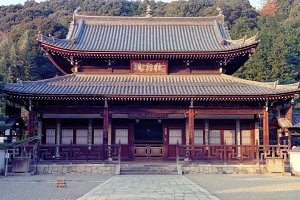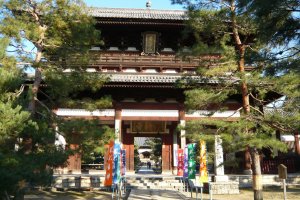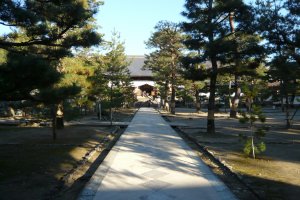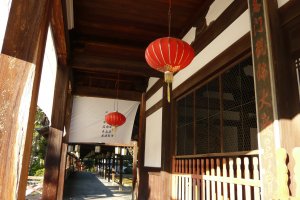Obakusan Mampukuji is the head temple in Japan of the Obaku sect of Zen Buddhism, and the teaching monastery for the sect’s student monks. Obaku is one of three Zen sects found in Japan, the other two being Rinzai and Soto. Obaku has some 460 branch temples throughout Japan.
The founder of Mampukuji was a Chinese Zen Master, Ingen (Chinese Yin-yuan, 1592 – 1673), who at the age of 29, entered the temple Mampukuji (Chinese Wan-fu-si) on Mt. Obaku (Chinese Huang-bo) in the Chinese province of Fukien (Fujian), eventually becoming its head monk. Having been invited to Japan, he arrived in Nagasaki in 1654. At that time, Nagasaki was the only seaport in Japan where trading with China and Holland was allowed.
Master Ingen spread the Dharma, the true teaching of Rinzai, in Japan, attracting many Japanese monks who came and studied under him. The Japanese were impressed by the new Chinese type of monastic life he introduced, characterized by a rigid and literal translation of the Buddhist precepts and the sandakaie (triple platform ordination ceremony), a superior ordination method new to Japan. Those whose respect he gained included the abbot of Myoshinji, Ryokei (1602-1670), who was to become a disciple, the retired Emperor Gomizunoo (1596-1680) and the fourth Tokugawa Shogun, Ietsuna (1641-1680).
In 1661 Master Ingen built a temple, Mampukuji, on a hill he called Obakusan, at Uji. The name was chosen to commemorate the Chinese temple of the same designation, and because of the number of Obaku (Chinese cork trees) found there. The Obaku was a useful tree to have in the environs of a monastery, for it has medicinal properties, being effective against abdominal disease, and is used to dye paper and textiles yellow. Mt. Obaku in China was where Zen Master Obaku Kiun (Chinese Huang-bo Xi-yun deceased 850), the master of Rinzai (Chinese Lin-ji) was ordained. The temple name, Mampukuzenji, translates as “ten thousand-fold happiness Zen temple,” had been given under imperial ordinance in 1614 by Emperor Shen-zong (1573-162) of the Ming dynasty. Ingen died at the age of 82; later emperors of Japan honored him with six posthumous titles granted in his memory on every fiftieth anniversary of his death. The Obaku sect achieved rapid progress at that time, and many branch temples were erected all over Japan by both Chinese and Japanese disciples.
The introduction of the Obaku monastic regulations to Japan represented an attempt to revitalize the Rinzai and Soto Zen, and it was to promote further reform movements during the middle Edo period. Obaku had an important influence on many aspects of Japanese culture, including calligraphy, painting, design, architecture, publishing, diet and medicine.
Ever since the Ming dynasty, Chinese Buddhism has moved toward syncretism. The dominant ideas and teachings of each period have adapted to that syncretism. A strong religious trend among lay people during the Ming dynasty was faith in the Pure Land (afterlife). Echoes of this faith are still to be found at Mampukuji in the daily service and the memorial services for the laity.
The Mampukuji temple complex has characteristics of Ming-style temples and contains a large number of cultural properties – twenty-three main buildings, the cloister between the Hatto and Tennoden and attached buildings dating from the mid-seventeenth century. There are also numerous well preserved important images, hanging wooden boards and carved calligraphy, paintings, wood-block copy plates of the Tripitaka and other artifacts.
Unique to Obaku is fucha ryori, vegetarian cooking in Chinese style. It originated from the special dishes cooked by monks and served after ceremonies to participants. Many visitors to Mampukuji have enjoyed this “taste of the Zen mind.”
Another cultural pursuit associated with Mampukuji is a tea ceremony called senchado (the way of steeped tea), in which high quality green tea leaves of two types (sencha and gyokuro) are steeped in a small pot of water. This ceremony is different from the more well-known chanoyu ceremony, which features powdered tea (matcha) whipped in a bowl. Senchado is based on Chinese Ming dynasty tea preparation methods introduced to Japan by Ingen and his followers. An Obaku priest, called Baisao (old tea merchant) popularized senchado in the eighteenth century and is enshrined at Mampukuji. The All Japan Senchado Association located at the temple hosts a large scale sencha tea ceremony twice a year and many sencha schools perform tea ceremonies at various locations within Mampukuji in the spring and autumn.



































